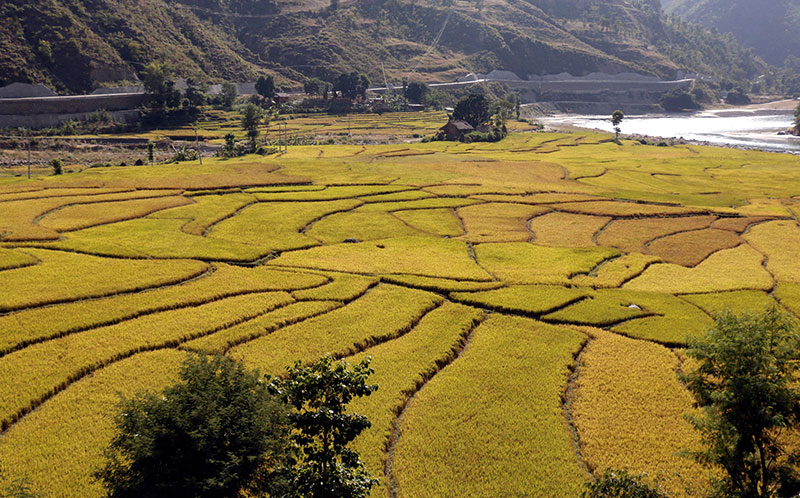
OR
Drop in rice production likely to hit national economy
Published On: January 4, 2020 08:05 PM NPT By: RSS

KATHMANDU, Jan 4: A noticeable fall in the rice production this year is likely to beat national economy. Experts predict that it would have its implications on the Gross Domestic Product.
Last year, contribution of agricultural sector to the GDP was measured at 27.59 percent. The Economic Survey of 2075-76 BS had projected the contribution of agricultural sector (agro products, forest and fishery) to the GDP to be around 26.98 percent.
Rice is the staple crop of Nepal and its stake in the GDP is 12 percent. The Ministry of Agriculture and Livestock Development in a press statement informed that paddy production went down this year by 1.05 percent compared to last year. It cited lack of timely rainfall, plotting of arable land, inundation in the Tarai/Madhes, lack of sufficient irrigation facilities and youth population deserting from agricultural activities as causes for the drop in rice production.
This year, country's rice production fell by 59,000 metric tons compared to the previous fiscal and it was limited to 5,551,000 metric tons against 5610,000 in the last year. According to the 2011 national census, around 6,000,000 metric tons of rice is required to meet the national demand. The Agricultural Census 2011 (2068BS) states that agricultural sector has its 32 percent contribution to the GDP.
Despite being an 'agricultural country', Nepal is heavily dependent on import for rice as other agricultural products and so many other commodities. Last year, it imported rice worth Rs 28 billion.
Cultivation of main season rice (which takes place during rainy season), spring rice (takes place during the Nepali month of Chaitra or pre-monsoon period) and Ghaiya (a kind of upland rice) is conducted in Nepal.
While analysing the data of the last 15 years (from fiscal year 2060-61 BS to 2074-75 BS), weather proves to be the major determinant for rice production. If it is favourable, the production goes up and when it is adverse, the production goes down. The total arable land in Nepal is 3,091,000 hectare.
Rice farming largely relies on rainfall for water. Of total arable land in Nepal, rice cultivation takes place in around 50 percent. In the last 15 years, it was 2003/04 (2060/61) fiscal year that witnessed maximum rice plantation. The rice was planted in 1.5 million hectares of land that year, while the production was 4.4 million tons of rice. After 11 years in 2015/16 (2072/73), the country planted rice in 1.3 million hectares of land, producing 4.2 million tons of rice. Every year, the land to produce rice is reducing.
The statistics maintained at the Ministry of Agriculture and Livestock Development, however, shows that the land for rice cultivation has been shrinking but the production keeps on growing. Currently, 1.3 million hectares of land is left uncultivated.
According to senior rice specialist Bholaman Singh Basnet, Nepal needs some 6 million metric tons of rice every year. Interestingly, Nepal houses the highest altitude arable land for rice cultivation- Chhumchaur of Jumla district. Similarly, Jhapa is the district producing maximum rice. The government has also announced Jhapa as the super zone of rice production.
In Nepal, all districts except Manang and Mustang grow rice.
You May Like This

NRB introduces cautiously flexible measures to address ongoing slowdown in various economic sectors
KATHMANDU, July 26: Nepal Rastra Bank (NRB) has taken cautiously flexible measures to facilitate cash flow in certain sectors including... Read More...

NRB to provide collateral-free loans to foreign employment seekers
KATHMANDU, July 26: Nepal Rastra Bank (NRB) through its monetary policy for the current fiscal year 2024/25 has introduced a... Read More...

NRB to review microfinance loan interest rate
KATHMANDU, July 26: The Nepal Rastra Bank (NRB) has decided to review the interest rate for loans to be issued... Read More...





Just In
- NRB introduces cautiously flexible measures to address ongoing slowdown in various economic sectors
- Forced Covid-19 cremations: is it too late for redemption?
- NRB to provide collateral-free loans to foreign employment seekers
- NEB to publish Grade 12 results next week
- Body handover begins; Relatives remain dissatisfied with insurance, compensation amount
- NC defers its plan to join Koshi govt
- NRB to review microfinance loan interest rate
- 134 dead in floods and landslides since onset of monsoon this year












Leave A Comment